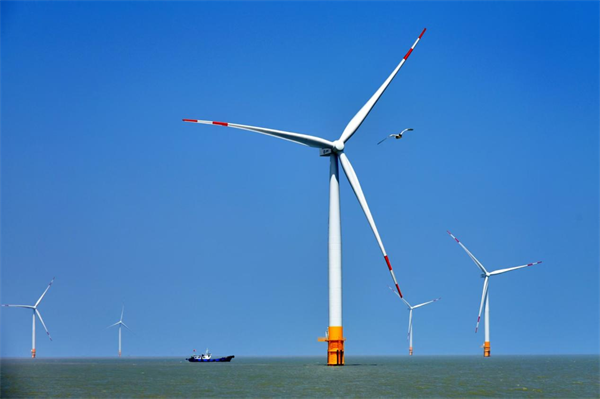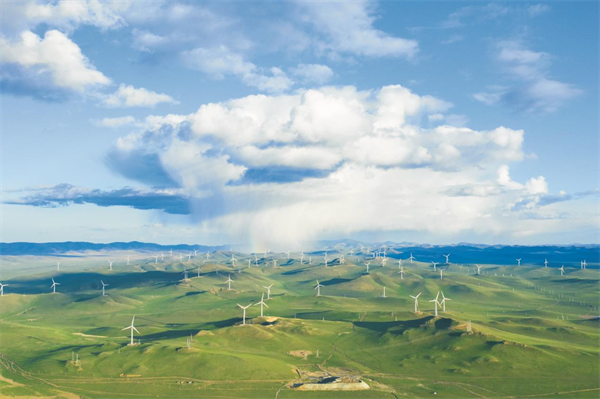This year marks the fifth anniversary of China’s announcement of the “dual carbon” goal. Over the past five years, the State Power Investment Corporation Limited (SPIC) has generated over 1.7 trillion kilowatt-hours of electricity through clean energy, reducing over 1.394 billion tons of carbon emissions. The comprehensive green and low-carbon transformation has achieved remarkable results, and a low-carbon development model has basically taken shape.
Continuously Optimize the Energy Structure
As of August 2025, SPIC’s power generation capacity exceeded 272 million kilowatts, with clean energy making up 199 million kW, or 73.16 percent. During the “14th Five-Year Plan” period, the installed capacity of photovoltaic power increased by 3.1 times, and that of wind power increased by 2.4 times.
SPIC has also developed several large-scale bases, including the world’s largest photovoltaic park in terms of installed capacity in Gonghe County, Qinghai Province.
As the largest single-site onshore wind power project in the world, the first phase of the 1,200-megawatt project in Ulanqab, Inner Mongolia Autonomous Region, has achieved full grid connection. Offshore wind power has also made new breakthroughs. The North H1 project in Binhai County, Jiangsu Province and the gigawatt-level offshore wind power project in Xuwen County, Guangdong Province, have successively won the National Quality Engineering Gold Award.

The North H1 project in Binhai County, Jiangsu Province [Photo/sasac.gov.cn]
In the field of nuclear power, the No.1 and No.2 gigawatt-level nuclear power units of the Haiyang Nuclear Power Plant have been in commercial operation for about six years. During this period, they have generated over 135.4 billion kWh of electricity, saving 57.88 million tons of raw coal and reducing carbon dioxide emissions by over 100 million tons.
Carbon Reduction Via Industrial Integration
SPIC has established and operated the integrated demonstration project of wind and solar energy green hydrogen production and ammonia synthesis in Da’an City, Jilin Province. This project can produce 32,000 tons of green hydrogen and 180,000 tons of green ammonia annually, reducing 650,000 tons of carbon emissions.
In hydrogen energy, SPIC has delivered over a thousand products such as buses, trucks, ships, and drones equipped with the “Hydrogen Forerunner” battery. A total of 30,000 battery-swapping trucks, mining trucks and construction machinery have been in operation, and more than 830 charging and swapping stations have been built, forming a low-carbon transportation network covering over 20,000 kilometers.
Low-carbon Technological Innovation
The CAP1400 third-generation nuclear power project has successfully achieved its first grid connection and power generation. On February 28, 2024, the first prototype of China’s independently developed F-class heavy-duty gas turbine with 300 megawatts was assembled in Lingang Industrial Area, Shanghai, and on October 7 of the same year, it achieved the first ignition success.
In the photovoltaic field, the high-efficiency N-type TBC battery developed by Huanghe Hydropower Development Co., Ltd. has achieved a conversion efficiency of over 26.08 percent. In the wind power sector, efforts have been made to improve the accuracy of wind power prediction and to carry out the construction of grid-connected wind turbine demonstration projects.
SPIC has steadily advanced the research and demonstration of carbon capture, utilization and storage (CCUS) technologies. Yuanda Environmental Protection Co., Ltd. has independently built the first domestic 10,000-ton-scale carbon capture facility for coal-fired flue gas. The project has operated continuously for over 20,000 hours, becoming the longest-running carbon capture project in the domestic thermal power industry.
Advancing the Green, Low-carbon and Circular Economy
SPIC has built the world’s first local power grid featuring “wind, fire and aluminum complementary operation” and established China’s first clean development demonstration zone for high-energy industries – the Huolinhe Demonstration Project for Circular Economy in the Inner Mongolia Autonomous Region. Through technological innovation and industrial upgrading, it has embarked on a green development path centered around the circular economy, achieving approximately a 30 percent green electricity consumption ratio for electrolytic aluminum.

The Huolinhe Demonstration Project for Circular Economy in the Inner Mongolia Autonomous Region [Photo/sasac.gov.cn]
An innovated industry chain for the green cycle, covering the research and manufacturing of efficient batteries as well as component recycling has been established. The pilot line for photovoltaic component recycling has achieved a comprehensive recovery rate of 92.51 percent.
SPIC has successfully fulfilled its obligations in the carbon market and led the development of the CCER (China Certified Emission Reduction) methodology for offshore wind power, which has been officially released by the government. The South No.3 Offshore Wind Power Project on the Shandong Peninsula has successfully registered as the first new CCER project in China.
International Exchanges and Cooperation
SPIC has actively participated in the the Belt and Road Initiative, and has been actively engaged in green project investment, green product trade, green financial cooperation, and green low-carbon technology cooperation. SPIC has established a dual-core supported green energy model in Kazakhstan, with units in Zhanatas in the south and Akmola in the north. This model has reduced carbon emissions by over 1.6 million tons per year, making it an excellent example for high-quality joint construction of the Belt and Road Initiative between China and Kazakhstan.
In October 2022, the Hunutlu Power Plant, China’s largest direct investment project in Turkey, with two 660-megawatt ultra-supercritical generating units, was put into operation. Its environmental protection indicators exceeded EU standards, and it can generate over 10 billion kWh of electricity annually.
(Executive editor: Wang Ruoting)